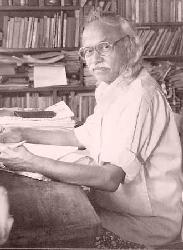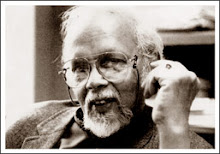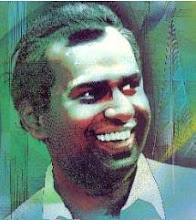 Author: Madhubhashini Disanayaka
Author: Madhubhashini DisanayakaSource: Sunday Times
Date:16th March 1997
The young Sugathapala de Silva
In an article published two years ago in the drama magazine 'Preksha', Simon Navgattegama speaks of a group of young players who had made a major contribution to drama in our society - the group 'Ape Kattiya' (Our Group). He concludes:
The change that occurred during the fifties and sixties in the Sinhala stage can still be seen in a mature form today. The change that Navagattegama speaks about is the portrayal of social problems on stage - the bringing in of social realism on to the field of drama that had been swept away into the form of stylized drama with its plots taken from myths and legends, distant in time and space, with the success of Sarachchandra's 'Maname' in 1956.
Though it is hard to agree with the belief that the universal themes that stylized drama usually dealt with had no relevance to the present, there did exist a criticism (and still does, as apparent in the article 'Hitting at Maname' in The Sunday Times of 16 February 1997) that the form that took the country by storm did not deal with the problems that affected its people.
Navagattegama speaks of the challenge of producing realistic drama in the fifties when the powerful "Peradeniya School" was propagating the stylized form which they considered to be closer to our traditional roots. '"Luckily for modern Sinhala drama, Ape Kattiya was stubborn enough to follow their own vision with obstinacy, completely ignoring the enormous challenge posed to them by the Peradeniya school."
 Sugathapala de Silva: Optimistic about the future of Sinhala drama
Sugathapala de Silva: Optimistic about the future of Sinhala drama
"The first name that comes to mind when I think of Ape Kattiya is Sugathapala de Silva", says Navagattegama. Banduala Jayawardena in his newest book "A brush stroke sketch of contemporary Sinhala theatre 1950-1980" (1977) says, "These plays (Sugathapala de Silva's Bodinkarayo - 1961, and Thattu geval - 1964) of the Ape Kattiya were in fact a concurrently growing protest movement against the so-called stylized theatre of tradition.
Sugathapala de Silva named this genre Thatvika or realistic drama, implying apparently that the plays which utilized myth and had lions, kings, princes and princesses for characters, had no relevance to reality. Plays of the Ape Kattiya, were on the other hand full of characters one meets in urban streets, boarding houses and mercantile offices...."
When there seems to be some interest in assessing the worth of stylized theatre in the field of Sinhala drama, it seemed fitting that we should meet the man who is supposed to be one of the founders of the opposing trend.
"I am against the word 'opposing'," says Sugathapala de Silva. "An artist is supposed to be a man of sensitivity. What has anger against another artist got to do with that kind of person? At that time what we wanted to show was that the stylized form was not the ultimate method. We had enough confidence in ourselves to go ahead and do what we believed in. We wanted to do the best we could - not put someone else down."
Also, the playwright believes that the form is subjugated to the content. He feels that the content itself would determine what the form of the drama should be. If we look at the last play of Ape Kattiya "Maratsad" (1987), we see that he does not hesitate to use a form that is far removed from realistic drama, when it suited what he had to say.
'We should be open to all styles from all over the world and enrich ourselves with what we can get," he says and this view shows why he feels that translations and adaptations have a positive influence on the drama of any country. "If we did not have drama from other countries to compare our productions with, then we can deceive the people here that everything we do is good.
"There must be a yardstick for people to judge. And why is it that we consider it all right to borrow from the West when it comes to Science and Technology, and it is wrong to do so in the field of art?" he asks, as a response to another belief that bringing in adaptations and translations of foreign playwrights was detrimental to original work produced within the country.
For Sugathapala de Silva, drama is, one way of expression. ln his involvement in it, he did not have a clear cut desire to serve any other idea than the desire to create. "Theatre is what I chose to express things I wanted to communicate. It is the expression that is important. The medium comes to one. Perhaps if my father had bought me a racing car when I was very young, driving may have been the medium of expression. Who knows?"
According to Bandula Jayawardena, however, Mr. de Silva's contribution has far reaching consequences: "But a daringly different tendency (than the drama that was done under political patronage) had been initiated in 1972 by Sugathapala de Silva in Dunna Dunu Gamuwe which had for background a company strike with trade union leaders, blacklegs and middle class wives as in Jayasena's Mana Ranjana Vada Varjana but the play ends entirely on the side of the strikers... the play opened the doors for an outburst that had been silently simmering among youthful playwrights. It took the form of a play of protest. Hindsight would make of Dunna a virtual Pandora's Box..."
Mr. Jayawardena feels that "neither de Silva's first attempt at traditional stylization in Nil Katrol Mal (1967) nor his Nandivisala (1977) attempting to make satirical use of a Jataka, nor the host of translations and adaptations he produced had as far reaching an influence as the Dunna."
It is not only in stage drama that Sugathapala de Silva has made a change for the better. His 19 years at the Sri Lanka Broadcasting Corporation had resulted in the radio plays done by the Sinhala Service at that time, becoming enormously popular. Since he had already had experience in stage drama it was not difficult for him to deal with radio plays, he says and apart from introducing many newcomers into 'Guvanviduli ranga mandala' (radio drama) he himself wrote scripts for it.
Says Palitha Perera, now the Director of the Sinhala Service, who worked in the same unit with
Sugathapala de Silva when de Silva first joined the SLBC, "Sugath had a very good sense of judgment, when it came to understanding the worth of scripts and the skill of newcomers. That was of enormous value." Sugathapala de Silva says that it was by watching Palitha Perera, who had preceded him at the unit, that he learnt how to tackle this new medium. As a response to that, Palitha Perera smiles to say, "coming from such a man as Sugath, that would be one of the greatest honors I could get."Sugathapala de Silva is also a writer of novels, now working on his seventh. His first novel,
Biththi Hathara (1963) (The Enclosure) which was turned into a film, has a protagonist whose life seems to have resemblance to the writer's own, specially with regard to the death of the mother at a young age, and the death of the closest friend in his youth. Asked about it, de Silva smiles to say, the first novel would always have an element of autobiography.Biththi Hathara is a story of a young man's journey through various relationships, of his finding (and losing) himself through his contact with others in the process of growing up. The criss-crossing of time in the novel though somewhat confusing to the reader, gives it, even at that point, an element of audio visual art. For a first novel, the depth that he explores with regard to the complex process of living and of feeling alive is impressive.
In his novels too one can see a trend that parallels his theatre work. There are novels - original and translated - that deal with political issues. His Ballo bath Kathi (Dogs eat rice) deals with the life of a high politician, with all its intrigues, complexities and hypocrisies. His fearlessness to tackle issues that are most often left alone is still apparent when he speaks of Shyam Selvadurai's 'Funny Boy's as a work that he might consider for translation. Homosexuality is not a theme that is usually dealt with in Sinhala literature. De Silva had touched upon that theme earlier in a drama and even in his novels, aspects of sexuality dealt in a forthright manner.
Born in 1928 in Weligama, de Silva studied in a few schools in Galle and after passing the tenth grade from Jinaraja College, Gampola, came to Colombo. The expectation of his uncle, who took care of his education, was that he should study to be a doctor. But one look at the frog that he had to cut, put an end to that education.
As a boy he had been exposed to the popular Tower Hall plays and the Minerva plays of the time, brought to Gampola by his uncle. With his grandfather, he had visited the many thovils that the grandfather had been very fond of seeing. And his curiosity to learn more about art had led him to books and a great deal of reading and learning. With such a background perhaps the decision not to be a doctor may not have surprised many. Also, in Colombo, his exposure to the world of art was greater and he made full use of it by going to see as many plays as he could.
His various jobs after that time included teaching English, and working at the K.V.G. Bookshop, where he could continue his dearly loved reading. It was when he was working on the newspaper, 'Sinhala Jathiya', that he was one of a group of young men who met regularly at the Indo-Ceylon Cafe to sip tea and bite into a wade and discuss art, and exchange ideas found in books that they had read individually.
The others of the crowd included Cyril B Perera, G.W. Surendra, Vipula Dharmawardena, Ralec Ranasinghe and so on.
"I used to criticise the plays that were running at that time quite a lot" says Sugathapala de Silva, smiling at the recollection. "And once, Cyril said, then you do one and show us. That was when I wrote Bodinkarayo".
That script was entered into a drama competition organized by the Arts Council in 1962. It won awards for the best script, best production and the best male actor. Just to prove that this was not a fluke, de Silva wrote his next play, Thattu Geval in the same style.
"To enter Bodinkarayo to the competition we had to fill a form which had asked which group was presenting the play. We just put 'Our Group' (Ape Kattiya) there," says de Silva speaking of the name that had since then become very well known in the field of Sinhala drama.
Another legend in this field, that of Maname and Sarachchandra, of whom it is generally believed, Sugathapala de Silva stood in contrast according to the recent article 'Hitting at Maname' comes to mind. Among other things, it does not seem fair to criticize Maname for the paucity of its imitations. And to think that Sarachchandra himself admitted that Maname did more harm than good in Sinhala drama, is to miss Sarachchandra's subtle humour and sarcasm completely.
Perhaps it is fitting here to mention that various forms of art, once created in a country, can only enrich it. Art grows in opposition and contrast. Sometimes the reason something new grows is the existence of the old.
Mr. De Silva himself is a proponent of enrichment by whichever way it is possible and holds that form really is incidental to what has to be said. His contribution to Sinhala drama has not been slight and even now the spirit of his creative power takes him to more modern mediums like the teledrama with equal vigour and enthusiasm.
With a cheerfulness that seemed characteristic, De Silva admits that it is becoming increasingly difficult to produce stage dramas, when television attracts most of the talent, but admits that it is inevitable, given the financial difficulties that most people have to face.
But he speaks with optimism about the future of Sinhala drama. He has detected a trend of upcoming young men in this field, who produce plays for the sheer joy of its creation. They are dedicated enough to the art not to be lured into commercial, popular productions and in them, he sees hope. And when such a man as he, who has been so long in the field and has done so much by his work, does not consider the future to be too bleak, perhaps we too can take heart.




































No comments:
Post a Comment